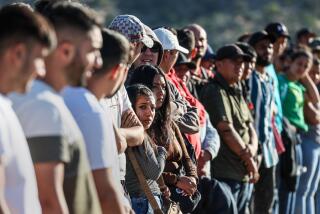Anti-illegal immigration activists look beyond California for action
For years, Raul Rodriguez Jr. would let out an exasperated sigh, then move on, whenever he read or heard news about illegal immigration. But something clicked last summer when he saw reports of multitudes of Central Americans illegally crossing the U.S.-Mexico border.
“I’ve got to do something,” Rodriguez, 72, said he told himself. “I’ve got to get off the couch and need to get people involved.”
Rodriguez crafted signs denouncing illegal immigration for various rallies, including one in Murrieta a few days after busloads of Central American detainees were turned back amid vocal protests.
After President Obama announced his immigration reform plan last month, the Apple Valley resident started contacting congressional leaders to express his displeasure.
California’s anti-illegal immigration movement has lost a lot of steam in the 20 years since voters passed Proposition 187, the ballot measure intended to deny taxpayer-funded services to those in the country illegally.
Polls consistently show that Californians don’t see illegal immigration as the same type of threat they did in the 1990s, and a September USC Dornsife/Los Angeles Times poll showed 73% of voters support some type of path to citizenship for those here illegally.
But the last few months have shown that the anti-illegal immigration forces remain small but potent — and a movement that backers hope will get stronger with Obama’s action.
Tactics this time are changing. Robin Hvidston, president of We the People Rising, a Claremont organization, said her group and other California activists have focused on targeting congressional leaders outside the state because they know there’s little they can do here.
“They see their only hope being the national government,” said Roy H. Beck, who heads NumbersUSA, a powerful national advocacy group opposing illegal immigration. “They don’t see a solution coming from inside California.”
People Rising and other groups campaigning against illegal immigration say they are experiencing a modest uptick in public interest and support as immigration has emerged as a big issue this year, a trend confirmed by the Southern Poverty Law Center.
But it’s not exactly a groundswell.
The protests in Murrieta garnered days of national attention and inspired similar demonstrations throughout the nation, according to activists and the poverty law center.
Obama’s plan, which would give work permits and temporary protection from deportation to nearly 5 million who are in the country illegally, did generate some protests, but they were decidedly small-scale. One last month in Rancho Cucamonga drew just six demonstrators.
Activists in California say that once the new Congress takes office in January, they are planning a phone and fax blitz in response to Obama’s move. Plans to join rallies in Washington, D.C., are also in the works.
Movement leaders said they want Congress to fight Obama’s executive action and to further secure the border with Mexico.
The renewed activity opposing illegal immigration in California reflects what’s happening on a national level, Beck said.
“They’re all enraged and engaged,” Beck said. “This issue is a white-hot priority within our followers.”
Leo Chavez, professor of anthropology at UC Irvine who has researched and written about the movement against illegal immigration, said an uptick in such activity is common when there are national events with high-media exposure, such as the border crisis last summer.
But whether the momentum will be sustainable is a question, especially in California, where dramatic political and demographic changes have taken place since the heyday of the movement in the 1990s.
Polling shows that Californians still have concerns about illegal immigration.
In the September USC/Times poll, 72% of respondents said illegal immigration is a crisis or major problem. The response was shared across ethnic, ideological, income and geographic lines, the poll found, even by those who support a path to citizenship for people who are in the country illegally.
Still, the state’s movement is a shadow of what it was in 1994, when California voters approved Proposition 187, a measure to deny public services — such as public schooling and healthcare — to people in the country illegally. Most of its provisions were struck down in court.
The movement deflated a bit, then picked up steam in 2005 with the rise of the Minuteman Project — a civilian militia patrol led by Jim Gilchrist of Orange County. The group took to patrolling the Mexican border in Arizona.
But infighting, violence and accusations of corruption dismantled the movement. The 2011 conviction of Minutemen member Shawna Forde in the murders of a man and his 9-year-old daughter in southern Arizona scarred the cause and drove many people out of the movement.
Many of the movement’s most active participants moved into the tea party, which put immigration on the back burner and focused their energy on defeating a number of Obama’s efforts, such as the Affordable Care Act, said Heidi Beirich, director of the Intelligence Project at the Southern Poverty Law Center, which tracks extreme right-wing and hate groups.
At the height of the movement in 2010, the center tracked more than 300 such groups. After that, it dipped dramatically to just about 30 last year.
Chavez, who has tracked anti-illegal immigration groups for years and wrote “The Latino Threat: Constructing Immigrants, Citizens, and the Nation,” said that the movement in California lost a lot of its momentum because of the demographic shift that has occurred since the mid-1990s.
This year, Latinos became the largest single ethnic group in the state, making up 39% of the population, according to the Pew Hispanic Center.
“Latinos are definitely a force to be reckoned with in California,” Chavez said.
After California, the crusade against illegal immigration moved east toward Arizona after a series of immigration-enforcement laws were passed there, but many were ultimately struck down by the courts.
Now, all eyes are on Texas, where conservative legislators have adopted many of the movement’s goals, especially after the crisis along the Texas border last summer.
“This is where California was in the 1990s,” Beck said.
Rodriguez, born in El Paso, Texas, to a U.S.-born mother and a father of Mexican origin who became a naturalized U.S. citizen and fought in World War II, said he doesn’t know whether his father came to the U.S. legally.
Regardless, he said, people should “get in line” and come and stay with permission, instead of crossing the border illegally or overstaying a visa and falling out of status.
The path to legal immigration to the U.S. is backlogged and very restricted, leaving those who do it through legal channels waiting for a very long time.
For instance, a Mexican national who is the adult child of a U.S. citizen must wait an estimated 20 years before filing for a permanent residency visa, according to a Migration Policy Institute report last year.
Rodriguez said he’ll continue to fight illegal immigration any way he can. Recently, he fired his gardener after learning he was in was in the country illegally, because Rodriguez believed keeping him on was unfair to U.S. workers.
“I haven’t found someone who I can hire to do the job,” he said. “But I’m willing to pay an American citizen to do that for me.”
Twitter: @thecindycarcamo
More to Read
Sign up for Essential California
The most important California stories and recommendations in your inbox every morning.
You may occasionally receive promotional content from the Los Angeles Times.











